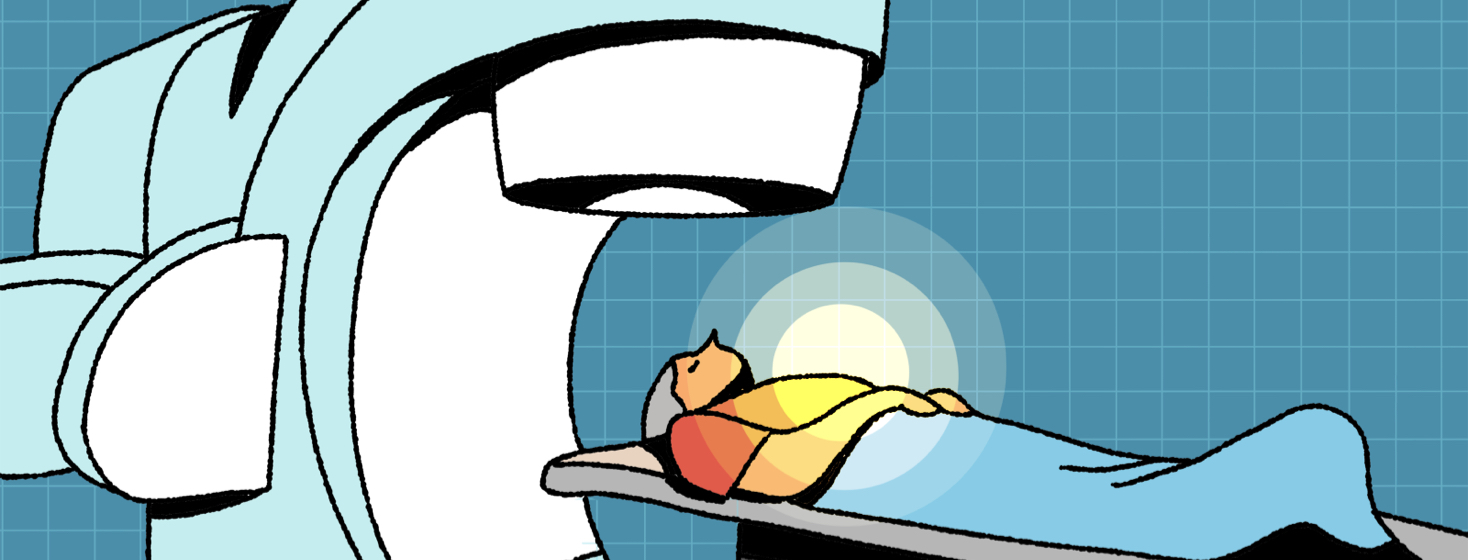Treating Small Cell Lung Cancer With Radiation Therapy
Reviewed by: HU Medical Review Board | Last reviewed: September 2025 | Last updated: October 2025
Radiation therapy uses high doses of radiation to kill cancer cells and shrink tumors. Sometimes called radiotherapy, radiation therapy can be an effective treatment for certain forms small-cell lung cancer (SCLC).1
Chest radiation therapy for SCLC
Chest radiation targets cancer in the lungs and the lymph nodes in the chest. The most common types of chest radiation therapy used for SCLC are external beam radiation therapy (EBRT) and stereotactic body radiation therapy (SBRT).1,2
EBRT
EBRT treatments use computers to precisely target cancerous tumor(s). This targeting minimizes damage to nearby healthy tissue. During EBRT treatment, a machine delivers a radiation dose to the cancer. The treatment is painless, and each session only lasts a few minutes.1
There are different types of EBRT radiation therapy, including:1
- 3-dimensional conformal radiation therapy (3D-CRT)
- Intensity-modulated radiation therapy (IMRT)
- Volumetric modulated arc therapy (VMAT)
- Stereotactic radiosurgery (SRS)
- Image-guided radiation therapy (IGRT)
These EBRT treatments vary slightly, but all deliver radiation to precise locations. For example, one produces beams from different directions at once, and another delivers beams as it rotates around your body.1
SBRT
Another chest radiation therapy used for SCLC is SBRT. It is also considered a form of EBRT. This treatment uses focused beams of high-dose radiation. Because of the higher dose, fewer sessions are generally needed.1
Brain radiation therapy for SCLC
Brain radiation for SCLC is called prophylactic cranial irradiation (PCI). It is often given to try to prevent the cancer from spreading to the brain, which is common. Like chest radiation, treatments are painless and last only a few minutes.1,2
Treatment recommendations for SCLC
Treatment plans for people with SCLC depend on the type of SCLC they have. People diagnosed with SCLC typically fall into 2 groups:2,3
- Limited stage SCLC – The cancer has limited spread in the body. It is present in just 1 lung and/or in the lymph nodes. Around one-third of people with SCLC have limited-stage SCLC at the time of diagnosis. People in this group generally have stage 1, 2, or 3 cancer.
- Extensive stage SCLC – The cancer has spread to more than 1 location in the body. For example, it could have spread from the chest to the liver, bones, or brain. Around two-thirds of people with SCLC have extensive-stage SCLC at the time of diagnosis. People in this group often have stage 4 cancer.
Limited stage SCLC
For people with limited-stage SCLC, treatment generally aims to cure the cancer and stop it from spreading. Radiation therapy and chemotherapy are often used together (concurrent chemoradiation). Surgery to remove the cancer is also sometimes an option.2
SBRT can be used for some people with limited-stage SCLC. It might be recommended for patients with stage I or II cancer who cannot have surgery. It might also be given to people who have a limited spread of cancer.1,4
PCI is also used as a treatment for limited-stage SCLC. It might be given to people who have stage 2 or 3 cancer if they responded to chemotherapy and chest radiation. Currently, brain radiation is generally not recommended for people who have stage 1 cancer.4
Extensive stage SCLC
Extensive-stage SCLC is not considered curable. For people with extensive stage SCLC, treatment aims to relieve symptoms and extend life. Radiation therapy is suitable for some people with extensive stage SCLC. However, chemotherapy and immunotherapy are more commonly used.2
Common side effects of radiation
The kind of side effects someone has when undergoing radiation treatment depends on where the radiation is aimed. These symptoms gradually build as they receive more radiation and may include:1,2
- Skin issues such as redness, blistering, or peeling
- Hair loss
- Fatigue
- Nausea and vomiting
- Weight loss due to loss of appetite or painful eating
Radiation to the chest area may cause a cough, breathing problems, or shortness of breath. Some people have redness on the chest or back, and feel pain when swallowing.1,2
If you are receiving chemotherapy and radiation at the same time, your side effects may be worse. But most side effects gradually get better after radiation stops.1,2
These are not all the possible side effects of radiation. Talk to your doctor about what to expect with radiation for SCLC.1,2
The stage of your cancer, as well as any other health concerns you may have, will affect which treatment is best for you. Your doctor can help you understand the benefits and risks of each type of radiation therapy.

Join the conversation